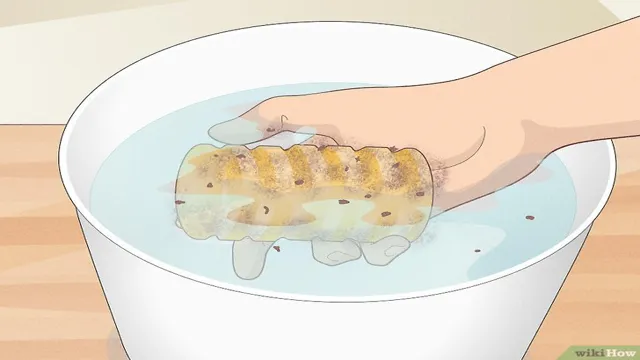How to Clean Aquarium Filter Bacteria: Expert Tips and Techniques

Keeping your aquarium clean and healthy for your fish is important to ensure they live a long and happy life. The most critical part of an aquarium’s filtration system is the beneficial bacteria that live in the filter. These bacteria aid in breaking down toxic waste that fish produce, keeping the water clean and the aquarium habitable.
However, it’s important to maintain the bacteria in the filter to ensure it continues to operate optimally. In this blog post, we will discuss the importance of cleaning your aquarium filter bacteria, how often to do it, and the steps to take to ensure your aquarium stays healthy.
Understanding the Importance of Clean Filters
If you’re a fish enthusiast, you understand how vital it is to keep your aquarium clean. One of the most critical steps in maintaining a healthy environment for your aquatic pets is cleaning the filter. The filter is responsible for removing debris and harmful particles from the water, keeping it clean and clear.
However, over time, bacteria and other contaminants can build up in the filter, affecting its performance. Learning how to clean aquarium filter bacteria is an essential part of keeping the water quality in your aquarium high. By regularly cleaning the filter, you will promote the growth of beneficial bacteria that helps eliminate toxins from the water, resulting in a healthier ecosystem for your fish to thrive in.
So, make sure to add filter cleaning to your regular maintenance routine to ensure the well-being of your aquarium and its inhabitants.
The Role of Bacteria in Your Aquarium Filter
Aquarium filter bacteria As a responsible aquarium owner, it’s imperative to understand the importance of clean filters. These filters serve as the primary cleaning system in your aquarium and play a crucial role in maintaining a healthy environment for your aquatic pets. The role of bacteria in your aquarium filter is essential in keeping your aquarium clean.
These bacteria break down the debris, waste, and organic matter in the filter, making it easier for the filter to remove them efficiently. The bacteria in the filter are essential to the aquarium’s ecosystem and help in the nitrogen cycle, which enables the breakdown of ammonia, nitrite, and nitrate in the water. The bacteria also help keep the pH levels stable, which is essential for the health of your aquarium inhabitants.
Without these bacteria, the aquarium’s water could become toxic, which could significantly impact your pets’ health. It’s important to remember that the role of bacteria in your aquarium filter means that it should never be cleaned excessively. Doing so could harm the bacterial colonies and disrupt the nitrogen cycle, causing the ammonia and nitrate levels to increase.
You should aim to clean your filter about once a month, or whenever there is excessive debris buildup. In conclusion, the role of bacteria in your aquarium filter is essential, and it allows your aquarium to maintain a clean and healthy environment for your pets. By understanding the importance of clean filters and maintaining them regularly, you can ensure a long and healthy life for your aquatic pets.

Identifying When It’s Time to Clean Your Filter
Keeping your aquarium clean is vital to ensure the health and well-being of your fish. One of the most important parts of an aquarium is the filter. Aquarium filters remove debris from the water, provide oxygenation, and support the growth of beneficial bacteria.
However, over time, the filter can become clogged with debris and waste, reducing its effectiveness. It’s essential to regularly clean your filter to maintain its efficiency and promote a healthy environment for your fish. But how do you clean aquarium filter bacteria? To clean your filter, first, turn off the power and unplug the filter.
Then, remove the filter media and rinse it with aquarium water. Avoid using tap water, which can contain chlorine and other harmful chemicals that can harm the beneficial bacteria. You can also use a filter brush to remove any debris from the filter’s intake tubes.
Finally, reassemble the filter and turn it back on. Remember to clean your filter regularly to keep your aquarium at optimal health, and your fish will thank you for it!
Common Signs of a Dirty Aquarium Filter
As a fish owner, it’s crucial to ensure your aquarium stays clean and healthy for your aquatic pets. One of the most important aspects of maintaining a healthy aquarium is keeping the filter clean. Some common signs that it’s time to clean your aquarium filter include reduced water flow, cloudy water, and a foul odor.
When you notice any of these signs, it’s important to take action immediately to prevent further damage or health problems for your fish. Cleaning your filter regularly is essential to remove any debris or waste that accumulates in the tank. Neglecting to do so can lead to a dangerous buildup of toxins and bacteria in the water.
To ensure your fish stay happy and healthy, it’s crucial to stay on top of the cleanliness of your aquarium filter.
Frequency of Filter Cleaning
As a pool owner, one of your responsibilities is to maintain your filter. Proper filter maintenance not only ensures the longevity of your pool equipment, but it also helps keep your pool water clean and clear. The frequency of your filter cleaning depends on various factors such as the type of filtration system and the level of pool usage.
It is recommended to clean your filter at least once a month, but more frequent cleaning may be necessary if your pool is heavily used or if you have a high amount of debris in your pool. Signs that it’s time to clean your filter include decreased water flow, dirty water, or an increase in the filter pressure gauge reading. By cleaning your filter regularly, you can avoid expensive pool equipment repairs and enjoy crystal clear water all season long.
Preparing to Clean Your Aquarium Filter
When it comes to cleaning your aquarium filter, it’s important to be cautious. After all, you don’t want to accidentally remove all the beneficial bacteria that keep your tank healthy! Start by gathering your cleaning supplies: a bucket, a clean toothbrush, a hose or faucet, and some aquarium-safe soap. Before you begin, turn off all the equipment in your tank and unplug it.
Then, remove the filter from your tank and take it apart, following the manufacturer’s instructions if necessary. Rinse all the parts in warm water to remove any loose debris. Next, use the toothbrush and soap to scrub away any buildup.
Be gentle but thorough, making sure to reach all the nooks and crannies. Finally, rinse everything again in clean water and reassemble the filter before replacing it in your tank. By cleaning your filter regularly but carefully, you can keep your aquarium ecosystem thriving without disrupting the delicate balance of helpful bacteria.
Gathering Your Supplies
Before you start cleaning your aquarium filter, you need to gather all the necessary supplies to make the process easier and more efficient. The first and most important supply is a replacement filter cartridge or media. It’s always a good idea to have a spare filter cartridge or media on hand, so you can replace the old one quickly without having to go out and buy a new one.
You will also need a bucket for water changes and cleaning the filter components, along with a hose or siphon to remove water from the tank. A scrub brush or sponge is useful for cleaning the filter components and removing any buildup of debris. Additionally, you may want to consider getting a filter cleaning solution to help dissolve any stubborn buildup.
With these supplies on hand, you’ll be ready to tackle the task of cleaning your aquarium filter and keeping your tank clean and healthy.
Shutting Off Power to the Aquarium System
When it comes to preparing to clean your aquarium filter, one of the first things you need to do is shut off power to the entire system. Turning off the power not only ensures your safety but also reduces the risk of any damage occurring to the filter or other equipment while cleaning. To shut off the power, you will need to unplug all electrical equipment that’s connected to the aquarium, including the filter, heater, and any other accessories.
It’s important to note that you should never attempt to clean the filter with power still running through the system, as it can be extremely dangerous. So, be sure to shut off the power and proceed with caution to ensure a safe and effective filter cleaning process. Remember, safety should always come first when it comes to maintaining your aquarium, and it starts with shutting off the power.
Cleaning Your Aquarium Filter Bacteria
Cleaning your aquarium filter bacteria is an essential task that every aquarium owner should perform regularly. Bacteria build-up can become a significant problem, leading to poor water quality and unhealthy living conditions for your fish. Depending on the type of filtration system you have, the steps for cleaning the filter bacteria can vary.
But generally, it’s recommended to turn off the filter before removing and cleaning the filter media. However, it’s crucial not to rinse the filter media with tap water, as it can kill the beneficial bacteria. Instead, rinse it with aquarium water, making sure to clean it thoroughly.
Cleaning your aquarium filter bacteria regularly can prevent ammonia and nitrate build-up and keep your aquarium’s water healthy and clear.
Removing the Filter Media
When it comes to cleaning your aquarium filter, one of the steps that you might need to take is removing the filter media. This is because the bacteria that are living in the filter media could be contributing to an imbalance in the tank’s ecosystem. While it may seem like a daunting task, removing the filter media is actually quite simple.
First, turn off the filter and unplug it from the wall. Then, remove the filter media and rinse it with warm water. Avoid using soap or any other cleaning agents, as they could harm the beneficial bacteria.
Once the filter media is clean, you can put it back into the filter and turn it back on. This will ensure that your aquarium’s environment remains healthy for your fish and other aquatic life. Don’t forget to repeat this process every few months to keep your filter bacteria in check.
Remember, a happy aquarium is a clean aquarium!
Rinsing the Filter Media
Cleaning your aquarium filter bacteria is an essential step to ensure the longevity and health of your aquatic pets. One crucial step in this process is rinsing the filter media. Over time, the filter media will accumulate debris and waste, and this accumulation can negatively affect the growth of good bacteria in your aquarium’s ecosystem.
When rinsing your filter media, it’s essential to do it with care, as it can disturb the good bacteria growth if done incorrectly. To rinse the filter media, it’s crucial to use clean, chlorine-free water. Never use tap water as it contains chlorine that can harm the bacteria.
Instead, use water from your aquarium or dechlorinated water. Once you have the appropriate water, gently rinse the filter media with it. Be sure not to rinse it too hard as this can damage the filter media and harm the bacterial population.
Rinsing the filter media regularly will help prevent clogs and ensure the good bacteria continue to grow and thrive, benefiting the ecosystem of your aquarium.
Cleaning the Filter Housing
Cleaning the filter housing of your aquarium is a crucial part of maintaining a healthy environment for your fish. Over time, the filter’s inner workings can become clogged with debris and bacteria, which can lead to poor water quality and even fish illness. To clean the filter housing, start by disconnecting the filter and removing the filter media.
Next, use a soft brush or sponge to gently scrub the inside of the housing, being careful not to damage any delicate parts or surfaces. Rinse the housing thoroughly with clean water, and reassemble the filter with fresh filter media. Regular cleaning of your aquarium filter can help ensure that your fish remain healthy and happy for years to come.
Maintaining a Clean Aquarium Filter
Maintaining a clean aquarium filter is essential for the health and well-being of your fish. A dirty filter not only affects the quality of the water but also increases stress levels in fish, causing them to become ill. One way to clean the aquarium filter efficiently is by using beneficial bacteria.
These types of bacteria help to break down waste and ensure that the water quality is optimal for fish. To clean the filter, begin by turning off the aquarium system and removing the filter media. Rinse the media with a hose using chlorine-free water and give it a gentle scrub to remove debris.
Do not use soap or bleach, as they can harm the beneficial bacteria. Reintroduce the filter media into the system and switch it back on. It is recommended to use bacteria-boosting supplements after cleaning the filter to restore and maintain healthy bacteria levels in the aquarium.
A clean filter allows fish to thrive in a healthy environment, and by utilizing beneficial bacteria, you can ensure they stay safe and happy.
Regular Maintenance Practices
Maintaining a clean aquarium filter is essential for the health of your aquatic pets and the overall water quality in your tank. A dirty filter can promote the growth of harmful bacteria and reduce the effectiveness of the filter, resulting in poor water quality. To maintain a clean filter, it’s important to conduct regular maintenance practices such as weekly or bi-weekly cleaning.
This involves removing the filter and rinsing it in clean water to remove any debris, such as fish waste and excess food. You should also replace the filter media, such as cartridges or sponge filters, every four to six weeks to ensure optimal performance. Neglecting to do so can lead to clogging and reduced water flow, which can harm your fish or cause stress.
In addition, it’s important to monitor the water levels in your aquarium to ensure that the filter is functioning correctly. A healthy filter means happy and healthy fish. So, make sure you keep up with your regular aquarium maintenance practices to maintain a clean and healthy environment for your aquatic pets.
Monitoring Water Quality
Maintaining a clean aquarium filter is essential for the overall health and well-being of your aquatic pets. A dirty filter can lead to a buildup of harmful bacteria and other toxins, which can endanger the lives of your fish and other aquatic animals. To ensure that your aquarium filter remains clean and efficient, it’s important to monitor the water quality regularly.
You can test the water for pH levels, ammonia, nitrites, and nitrates, all of which can have a significant impact on the health of your aquarium inhabitants. Checking the water quality will give you a better understanding of the current state of your aquarium, and help you to make any necessary adjustments to maintain a healthy environment. By regularly monitoring your aquarium filter and water quality, you can help to keep your aquatic pets healthy and happy.
Replacing Filter Media as Needed
Maintaining a clean aquarium filter is crucial for keeping your aquatic pets healthy. One of the most important aspects of this maintenance is replacing the filter media as needed. Over time, the filter media can become clogged with debris and waste, reducing its effectiveness at removing harmful substances from the water.
To prevent this from happening, it’s important to regularly check the filter media and replace it if it appears dirty or damaged. The frequency of replacement will depend on the size of your aquarium and the type of filter you use, but a good rule of thumb is to replace it every 2-4 weeks. By keeping your filter media clean and fresh, you can ensure that your aquarium environment remains safe and healthy for your fish and other aquatic pets.
Conclusion and Final Thoughts
In conclusion, cleaning your aquarium filter bacteria is essential to maintaining a healthy and thriving aquatic environment. However, it’s not just about scrubbing away visible dirt and grime. To truly clean your filter, you need to understand the delicate balance of the ecosystem living inside it.
So, if you want to be a master of aquarium maintenance, be sure to approach your filter with care and mindfulness, because after all, a healthy aquarium is a happy aquarium.”
FAQs
What are some common types of bacteria found in aquarium filters?
Some common types of bacteria found in aquarium filters include nitrosomonas, nitrobacter, and beneficial heterotrophic bacteria.
How often should you clean your aquarium filter to remove bacteria?
It is recommended to clean your aquarium filter every 2-4 weeks to remove excess debris and accumulated bacteria.
Can bacteria in an aquarium filter be harmful to fish?
No, bacteria in an aquarium filter are actually beneficial for fish as they help break down harmful toxins, such as ammonia and nitrates, in the water.
Will using chemicals like bleach or ammonia on your aquarium filter harm bacteria?
Yes, harsh chemicals like bleach or ammonia can harm or even kill beneficial bacteria in your aquarium filter, leading to an imbalance in the ecosystem.
How can you naturally maintain beneficial bacteria in your aquarium filter?
Natural ways to maintain beneficial bacteria in your aquarium filter include using live plants, adding substrate like sand or gravel, and limiting the use of chemical additives.
What are some signs of bacteria imbalance in an aquarium filter?
Signs of bacteria imbalance in an aquarium filter include cloudiness in the water, algae growth, elevated levels of ammonia or nitrates, and sick or stressed fish.
How can you prevent the buildup of harmful bacteria in your aquarium filter?
To prevent the buildup of harmful bacteria in your aquarium filter, regularly clean your filter and perform partial water changes, avoid overfeeding your fish, and ensure proper water circulation to promote oxygenation.






